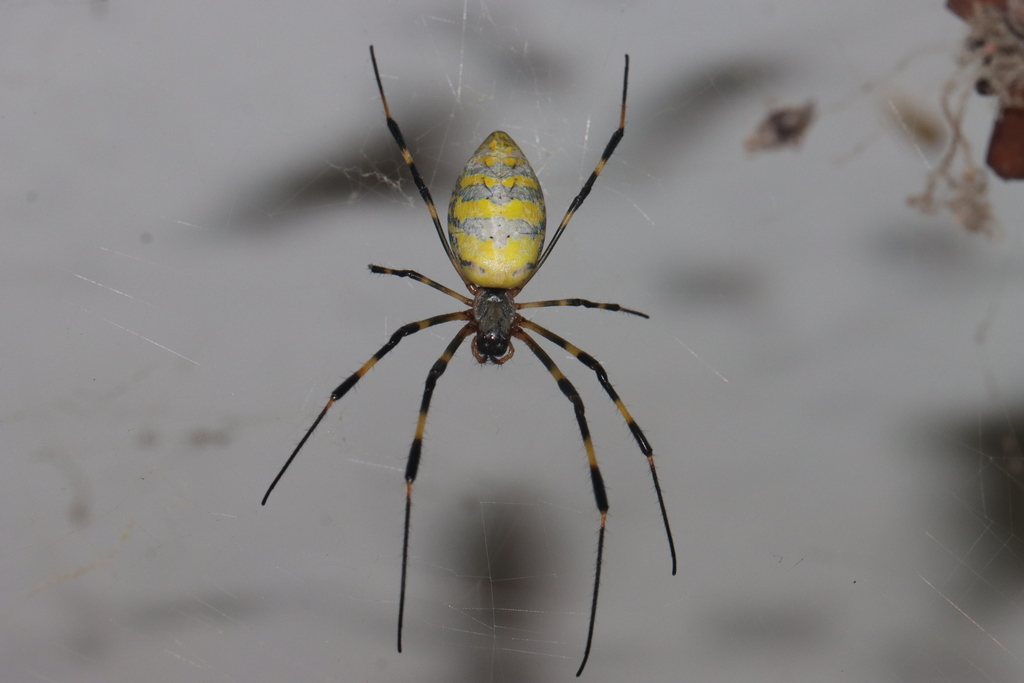iNaturalist October News Highlights
We are embracing the Halloween spirit with a spider theme woven through these iNaturalist impact highlights from October 2023! If you missed last month's highlights you can find them here.
Invasive Species Science

@ashleytwahlberg’s new study in the Journal of Arachnology used iNaturalist data to assess the invasion of the Brown Widow Spider across the Americas. Similarly, @dcoyle and colleagues at Clemson Extension are using iNaturalist to track the invasive Joro spider in the southeastern United States.
Not to be outdone, October is also Spotted Lanternfly season. You can read here about @tanya_campbell’s observation documenting lanternflies creeping into Canada and iNaturalist help tracking this invasion from Maryland to New York. This story highlights @drcrayfish’s help identifying invasive crayfish in Canada, while this story highlights iNaturalists use in understanding the Chinese Mitten Crab invasion in the United Kingdom.
Climate Change Science

Leaving our spider theme for a moment, our favorite climate change story was about @sgorta and colleagues using iNaturalist data to understand biodiversity responses to recent Australian megafires.
Check out this study using iNaturalist to understand the climate change impact of methane emissions from termites, and this story about @clairegoodwin_hmsc’s work using iNaturalist to document out-of-place species in marine ecosystems driven by climate change.
Science Discoveries

Our favorite science discovery from October was this story about @louwclaassens use of iNaturalist to discover a new species of pipehorse. The effort leveraged the iSeahorse project on iNaturalist which turned 10 years old this month.
There were many examples about range extensions like this story about @nedster and @nicolem42’s discovery of Lemon Cuckoo Bumble Bee in Illinois, @silviatav’s study on the discovery of stalked jellyfish in Portugal, a worm lizard range extension in Brazil, new millipedes reported from the Canary Islands, and hybrid buntings reported in Russia.
Conservation and Monitoring

Back to our spider theme, this great article makes a compelling argument for how observing spiders can help us understand why they are declining with iNaturalist anecdotes from @mira_l_b and @bnm50.
In other news, Newsweek and CapetownEtc told the story of @eugene_hahndiek’s thought to be extinct flower posted from South Africa that Custodians of Rare and Endangered Wildflowers (CREW) identified. Read more about CREW’s use of iNaturalist in this recent Biodiversity and Conservation article. We loved @elia_van_tongeren and colleague’s paper on how iNaturalist helped understand butterfly extinction patterns in Italy and stories about monitoring declining Christmas beetles and bandicoots in Australia.

Don’t miss ScienceFriday’s excellent piece on @akilee and colleagues monitoring the spread of Beech Leaf Disease. This article described @scott654’s study assessing potentially at risk Illinois hoverflies, while other studies used iNaturalist to assess West Atlantic marine taxa, butterflies in Ecuador, and cactus biogeography.
Lastly, we couldn’t resist this photo from @rony_alberto_garcia_anleu of @seyner and Wildlife Conservation Society colleagues using iNaturalist to monitor species in Guatemala’s Maya Biosphere Reserve.
Roadkill and Landscape Connectivity

No spiders here, but equally ghoulish, this article highlighted the value of roadkill observations @damonyeh and colleagues’ Tahoe Basin Connectivity Study. In Australia, this story described @katyw’s use of roadkills on iNaturalist to find wombat road crossing hotspots as part of her rescue work. Roadkill observations helped @raul_pommer and colleagues study the distribution of Crab eating fox in Brazil while this story links reporting roadkills to iNaturalist with snake conservation in Vancouver.
iNaturalist Impact on AI Research

Yesterday, New Scientist described mind-blowing research by @carlosemunoz using iNaturalist images to train a Neural Network to show how insects like @tshahan’s moth pictured here mimic spiders to avoid predation.
iNaturalist images contain a tremendous amount of information that help scientists study everything from how monarch caterpillars and woodsorrell are changing color to adapt to climate change, to helping morphologically delineate Chilean geckos, to public health science around exposure to poison ivy, to @marinejanine’s sea dragon behavior research.

iNaturalist images and AI tools are supercharging this Phenotypic Revolution by allowing scientists to more easily detect and measure phenotypic patterns. Two articles on image analysis with iNaturalist appeared in this month’s special issue of Applications in Plant Sciences. One offered new tools for extracting color patterns from iNaturalist images while the other outlined new techniques for improving the usefulness of iNaturalist photos for image analysis.
Meanwhile, the iNaturalist dataset has become a standard benchmark dataset for the Computer Vision community as evidence by its use in papers this month by Jinglun Li et al., Panos et al., Lianbao Jin et al., Zikai Xiao et al., and Anonymous authors. Caltech incorporated an iNaturalist scavenger-hunt into an AI event on campus this month which highlights this virtuous cycle between iNaturalist and the AI research community.
iNaturalist for Land Stewardship

This role of iNaturalist in bridging native species, bioregionalism, and stewardship was highlighted by author Jenny Odell in a talk from earlier this month. We were inspired by @thenectarbar’s quote: “if every single person would make a 10-foot by four-foot space and dedicate it with native plants then we are doing our part to put the diversity back” from this story about Texas gardeners using iNaturalist to identify native plants. @robdv’s excellent article describes using iNaturalist to attract native insects while this article highlights using Seek to help rear and restore butterflies. Beyond planting and attracting native species, @andreakautz explains in this article how iNaturalist can be used to identify and remove invasives from gardens.
This article details the excellent work of @vmacphail and other Pollination Guelph volunteers who used iNaturalist to log hundreds of species at restored sites that were just bare sod a few years ago. Other events that incorporated iNaturalist into restoration themed events included this story on Rosemont Preserve Restoration Day, this story on the upcoming Armour Hill Clean-up, and this story on the Wall Street Journal’s Giveback Day 2023. Lastly, this story highlights @luisfssantos and colleague’s use of iNaturalist to document a rare plant as part of efforts to purchase and preserve a Portuguese wetland.
October iNaturalist Events

Coverage of spider themed October events included the North Carolina Spider Search and Aracnoctubre. Keeping with the Halloween theme, we loved the coverage of the Life in Our Cemeteries iNaturalist event in Australia.
Student led bioblitzes were highlighted in this article about the North Carolina Campus Nature Challenge, and this article about the CASS Minibioblitz in New Zealand. Lastly, this video features a Wisconsin Tyke Hike by the Delafield Public Library in Wisconsin.
iNaturalist’s Human Health Impact

This article profile’s @scarlett_smout’s research on healthy bodies and minds and her use of iNaturalist. Likewise, this Guardian article endorses iNaturalist and Seek as great apps for connecting to nature. But how do people connect to nature if they can’t get over their fear of creepy crawly things like spiders? Backpacker editor and spider enthusiast Adam Roy describes how and the role of iNaturalist in this excellent podcast.
Several stories mentioned using iNaturalist in seasonal nature activities to help people connect to nature such as enjoying fall foliage in Central park with @carey_russell. Many stories focused on mushroom hunting ranging from this story on @allthingsfungi’s efforts to get people overcome their fear of fungi, to @mycology_mike leading mushroom hunts around Oberlin College, to @nschwab’s Mycoblitz Europe project, to this story about @bdthomas mushroom foraging in Rhode Island. This article describes using iNaturalist to get started with foraging. Please remember to forage responsibly!
iNaturalist’s Education Impact
This study details @ulfi_faizah's experience incorporating iNaturalist into a University biology course in Indonesia, while two separate Brazilian studies assessed iNaturalist’s use as a remote learning tool for teachers here and here. This article on @biolily’s work at Autonomous University of Nuevo León high schools in Mexico exemplifies how great teachers are using iNaturalist in the classroom. Also check out this article on @craig_williams work using iNaturalist to build curricula around mosquito monitoring in Australia and this article on @ptimmldne use of iNaturalist with students in Nebraska.
iNatters in the News
This month, we featured spider researcher @ajott in an identifier profile. We loved this profile on ecology professor and bird photographer @phylogenomics. Check out this article on scientist and prolific iNaturalist identifier @cehmoth’s work to catalog moths in Montana. This profile highlights Native Bee Society of BC's Bee Tracker creator @beespeaker’s work helping pollinators. This article highlights @jlmason’s work conserving the Ontario Carp Barrens, and this article summarizes a talk by @danbachalis about surveying species in Hammonton, New Jersey.
Thank you to everyone who participated in iNaturalist this October! Your support makes it all possible.





댓글
Thanks for sharing! Here's the link to my article that's mentioned above: https://blog.wfsu.org/blog-coastal-health/2023/10/bang-for-your-caterpillar-buck-which-plants-host-the-most/
thanks for the catch robdv! We added the link above
Wow, so much great stuff!!! Congratulations everyone!
As always amazing info
Thanks for these fascinating observations.
Thanks for sharing these fascinating observations.
I love this summary! Thank you
Interesting info! Thank you!
Thanks for the shout out!!!
The spider friends of central texas project was originally created for my masters thesis project :) I still like to check it and ID spiders!
Thanks for mentioning my study! iNaturalist patrons and the data they produce is incredibly valuable.
Thanks for sharing our project and highlighting the importance of roadkill observations!
This summary is a great idea! Hope to see one every month!
Thank you!
Typo in the word "help" in first sentence of second paragraph of the Human Health subsection. @loarie
@hmheinz thanks - fixed!
Really exciting stuff! I love seeing how much iNaturalist and citizen science contributions can help out researchers. Keep up the good work everyone!
Innovative and resourceful projects.
Thank you for bringing our attention to them.
WOW!
This is a fantastic collection of success cases and motivating events happening all around, it is really limited on the outreach by the language :(
I would really like to break the barrier language for the non English speakers :(
@aztekium Yeah good point, translators would probably be a big help to reach more people. I imagine it'd all have to be volunteers though
@jaime_a It could be fairly easy to use Google or deepl to translate at least the short text and then redirect them to the original source. but were to share it?
댓글 추가